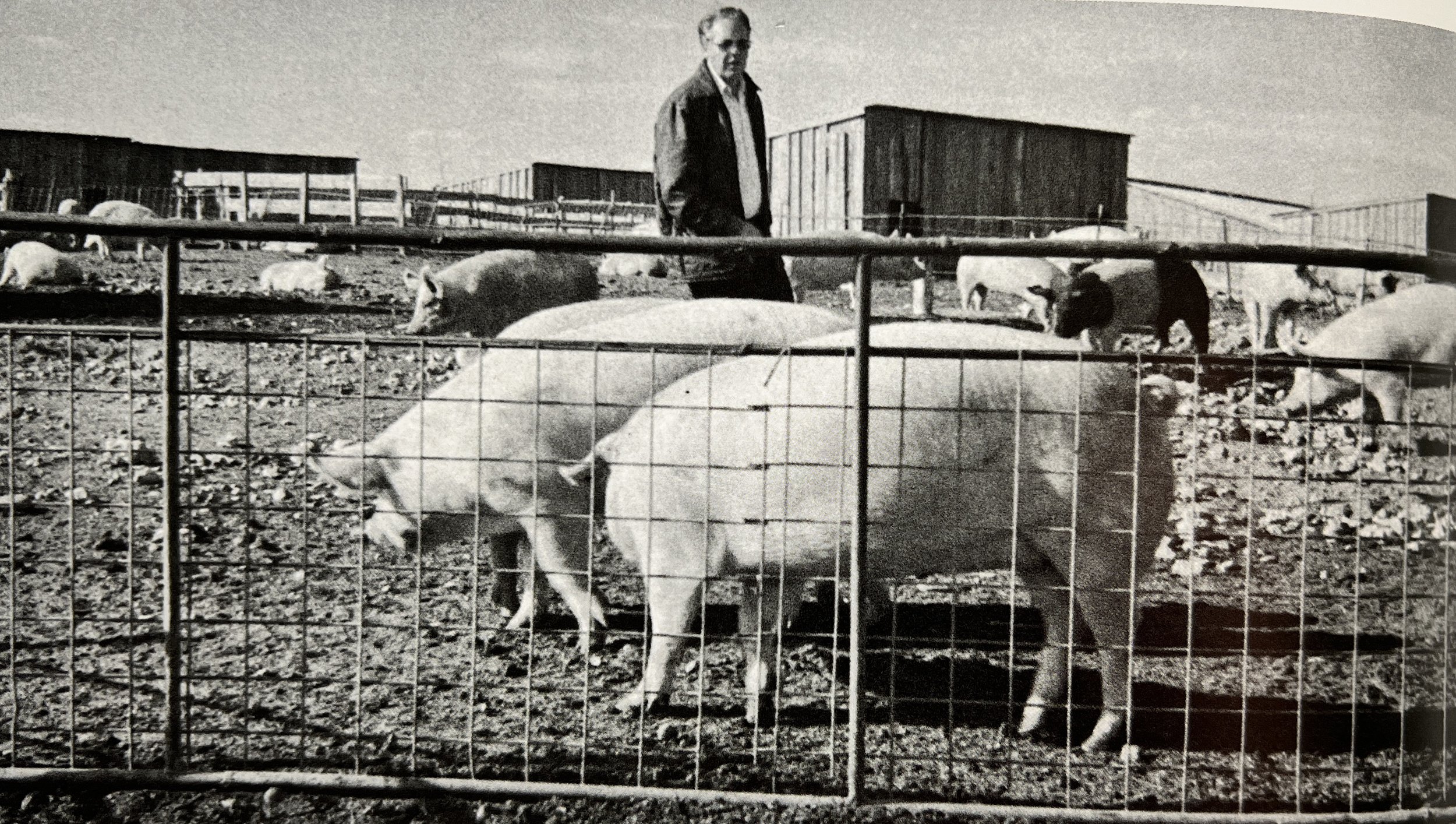James Caldwell
Jim tending the animals and checking his hog stock
Snowflake - Navajo County
Inducted in 2014
Canadian-born James D. Caldwell was a leader in breeding Specific Pathogen Bred pigs. Starting in Snowflake in 1966, his farm grew to 7,100 sows and 400 boars, producing over 100,000 pigs annually.
Canadian-born James D. Caldwell has been raising pigs in Snowflake since the mid-1960s. James was born in Cardston, Alberta, approximately 16 miles from the US border in 1928. His grandparents had become Mormon church members and moved to Utah in the 1890s. When they heard about land available for homesteading in Canada, a family of farmers and ranchers migrated north in 1897.
James was the oldest of eight kids. When he was 20 years old, he went to Australia to work as a Mormon missionary for two years. Returning home, James worked for the Lands and Forestry Department in Edmonton, Alberta, then moved to Laduc, where they had just struck oil. Later, when his younger brother Ray decided to go to Brigham Young University, his mother asked James if he would go with him, and he did. He found a job at Utah State Mental Hospital, where his shift allowed him to take classes at the University.
During his days on campus, they have rewarded him with more than a degree. He met Dixie Flake, the daughter of a pioneer rancher from northern Arizona. They were married at the Mormon temple in Mesa on December 20, 1954.
"When I graduated from BYU, I majored in animal husbandry and had a minor in chemistry. I thought people weren't hiring graduates in the animal industry, so I decided I had better get further education. I had done some assistantship at the University of Minnesota and their agriculture department, so I went there," he said.
James acquired his love of pigs while studying animal genetics at the University of Minnesota and later as a faculty member and student at the University of Nebraska. He and Dixie had two sons, and his job at the University only paid $200 a month. James talked to one of the professors about his financial situation and the possibility of leaving school. He needed to get a job where he could support his family. The professor suggested that he apply to a research project by the University of Nebraska on specific pathology breed pigs. They were looking for a fieldman. James got the job, raising his income to $4,500 a year. You might say he was in hog heaven. In addition to substantially increasing his income, he finished his master's degree project with pigs taken by cesarean section and raised in a germ-free environment. The pigs were brought to Nebraska farms with a disease problem. If they had eliminated all the diseased animals, they would have re-populated the farm with disease-free pigs. From there, he moved to Chillicothe, Missouri, to work for two veterinarians who planned to set up a laboratory in the same field. They stayed there for about a year.
Dixie's father, Virgil Flake, was a cattle rancher developing a new farm with his sons. He contacted James to see if he would like to go to business with them. In 1960, Dixie and their four children moved to Snowflake, a town named after two Mormon pioneers, the Snows and the Flakes.
In the early 1960s, there was a downturn in the cattle industry. Virgil decided not to follow through with his plans, so James worked as a chemist at the Snowflake Paper Mouth. Not a paper chemist's heart, James finally found a job with a doctor in Illinois. The project went under in about a year and a half, but two weeks before it did, James was approached by the Neuhoff brothers in Texas, who offered him a job managing a pig farm. At first, he turned it down, but when faced with the reality of a job in Illinois disappearing, he called them back and accepted the position. The only drawback was that the church was a 50-mile drive one way. Instead, James took a research job at the University of Nevada. In 1966, Dixie's father died, and her brother offered James land to start his pig farm in Snowflake.
The Snowflake operation started in 1966 with 21 weaner gilt pigs, $6,000, and a piece of land given to him by his brothers-in-law. After receiving a security loan from FHA, he went to the Midwest and bought a York gilt and boar in Iowa, then on to Nebraska, where he purchased a Hampshire gilt and boar. By 1968, his herd had grown to 225 sows through suitable breeding methods, and he began looking for more extensive facilities. Jim bought more land from his brothers-in-law and increased his herd to 500. By retiring, James had several farms and a mill in the Snowflake area. They had 7,100 sows and 400 boars at one point, producing over 100,000 pigs yearly. The operation had 75 employees over the years—four of his five brothers and several sons-in-laws partnered with him.
James and Dixie had nine children, 42 grandchildren, and 58 great-grandchildren.
"The Snowflake operations started in 1966 with 21 weaner gilt pigs, $6,000, and a piece of land given to him by his brothers-in-law.
Affiliations
Arizona Pork Producers — Board
Arizona Livestock and Sanitation Board — Appointed by Governor Jack Williams 1971
Arizona Pig Producer — Board
Arizona Livestock — Board
Snowflake School District — Board
Navapache Hospital — Board
Professional Farmers of America
LDS Church — Mission President (1984-1987)
Awards
FFA Farm Family of the Year (1974)


